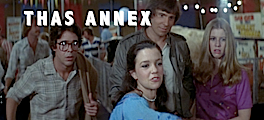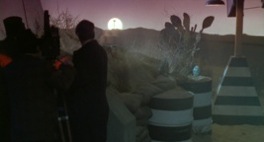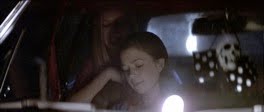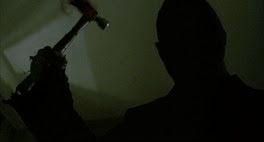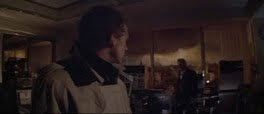A film whose sheer and plain unorthodoxy is the claim to its specialness, somehow often unperceived: a barrage of deliberateness confused for "cheese," an exquisite neutrality confused for schlock, the delineation of content - entire textual meaning - seen as expository dearth, and a series of tonal contemplations, scene upon self-contained scene, viewed as the plodding death of over-encumbered movie-plot. Lifeforce's tone and constant rhetoric, its intents (which includes its humor) and grand design, are too precise, too elegant. The comprehensive thoughtfulness of design is, in fact, contrary to cheese; the eschewing of the cheaper ploys of audience satisfaction, anywhere below finding deep satisfaction in the neutral zone that is wit and distanced rhetoric, contrary, in fact, to schlock.
If
I could make the claim that there is nothing, in fact, "schlocky"
about Lifeforce, then let me just say there is
nothing schlocky about Lifeforce, just
as there is nothing schlocky about the Sistine Chapel - outside of their painstaking and highly intricate narrative-space-time compactions of genesis stories, perhaps involving the humble, finger-outstretched touch of a
powerful, generative otherworldly being and many nude people. It's a little sensational, I suppose. Perhaps a
little mental exercise is in order: one in which
we attempt to let go of all 1-to-1 notions we have of the signposts (and
attendant pleasures) of schlock, such as nudity and wanton spectacle. If
we let go of this notion that pleasurable nudity and a prerequisite of whiz-bang spectacle are guarantors of schlock, then maybe you'll see there is little to
no reward in applying the label to so purposeful a work of art.
Nothing
of such specific, multifaceted, elegant design can be schlocky, if we are to be
attendant to all connotative ingredients of the definition, which so often
includes conditions of inattention to craft and inelegance of thought.
The idea that this work is emblematic of inattention
to beautiful craft and a crudeness or
shallowness of moral thought is truly a matter about which I must adamantly
disagree.
So
what if Michelangelo is working with
some seriously sleazy Old Testament subject matter, replete with talking snakes, drunken Noah exhibitionism, and calamitous natural disaster? The Sistine ceiling is a feat of
technical skill and meticulousness, of complex visual scheme involving
intricately arranged dimensional space, and of rich, allegorical storytelling
and bold structuralist concept, as Michelangelo literally collapses the
conceptual realms of the story he is telling with the medium he works in
(fresco that is part of a prodigious piece of architecture), conflating the epic-theater telling of
religious tale with the sublimely formal architecture -- architecture being something both sublimely aesthetic and sublimely rigorous -- of the structure that exists
to promote it: the gods, prophets, angels, and icons literally drape and exist within the painted, fictive "ceiling architecture" Michelangelo renders through glorious illusion,
and simultaneously uses to compartmentalize and thus compact the Book of
Genesis history he depicts. The stories are enacted embedded within a symbolic
framework of glorifying architectural display, history held within the very rafters, the characters acknowledging
their presentation atop the plinths and afloat the cornices, draped and leaning across the rib of
columns that otherwise exist to divide their separate dramas, emerging or dimensionally
interacting tromp l'oeil-style with
the network of arches and beams of the allegorical fictive architecture while
simultaneously blending seamlessly into the pendentives and actual architecture.
*
* This is primitive Brechtian idea here, the
laying bare of the medium (the grand chapel) - primitive because it is before
modernism discredited the idea of seriousness and formalist substance being
capable in the mainstream's traditional storytelling, such as the religious establishment's erection of bombastic monuments for their narratives; sounds much like Hooper's place in his Hollywood art-making, where he embodies a push-pull between the threat of frivolousness and his belief in cinema-in-general's substance: he makes sentimental, commercial narratives to a degree but severer creations to a greater one; he is traditional but non-traditional, populist but highly formal, ostensibly a part
of a commercial system (Michelangelo had Julius II, Tobe Hooper had Menahem
Golan...) but somehow manages the creation of transcendental work through personally-upheld artistry.
And
so similarly exists Lifeforce, as no
film so purposeful, enigmatic, and elegant, painterly in design can be done in the
service of "schlock." As Michelangelo's Genesis happens across
the allegory of architecture, painted in his style with fresco, Hooper depicts
the genesis of mankind by creating an allegorical action film, painted in his
exquisite style with the camera. It is the manipulating of an action film
(laid bare is the medium: those British sci-fi action films Hooper loves so
much, serving as his architecture and framework - cinema his temple - with
which to hang his own rich vision, achieving the rarefied concept while
simultaneously blending in seamlessly the affectionate homage to those 60s British sci-fi films) to accommodate a story with deeper allegorical
tendrils and a lofty rooting in a moral spiritual outlook. Thus, as
Michelangelo conflated his Book of Genesis with the architecture of the great
temple dedicated to its telling, Hooper conflates his genesis spectacle with
the vessel of the action movie, in which the divinity of life persisting, on
Earth and elsewhere, is conflated with action movie pay-off and resolution (the great profound point in the film's finale - perhaps cheesy, mostly
beautifully enigmatic - being in how the Space Girl is "defeated" with
the sword, but in an act that is actually a greatest romantic gesture,
suggesting one lover not being able to be destroyed without the destruction of
the partner; the Space Girl is banished but with her "love" in tow and the order to seed their collected energy elsewhere).
In
conclusion of my Lifeforce/Sistine
Chapel bait-and-switch attempt, we can say that Michelangelo had the Roman Catholic
Church and Tobe Hooper has the film industry, either being very likely establishments
where making art is not necessarily the highest priority. But if they
both aimed to create works contrary to the schlocky commerce often involved in
their respective institutions, then lets deem pinning down Lifeforce or the Sistine Chapel as "schlock" - regardless
of how innocent your intentions may be (I too crave the pleasure of good schlock now and
then, but gross that it is used brazenly as a selling point - I'm looking at you, Scream-Factory-Blu-Ray-release-back-cover...) - as the greatest insult to them. We would be defining these works by those
aforementioned 1-to-1 signposts, preconceived by us via knowledge of the
institutions they work within and the less-inspiring norms that may come out
from them (a Cannon film with chaste T&A, so it must be for 12-year-old
boys! As I said, Lifeforce's
claim to specialness is truly found in its contrariety).
Ignoring
those things, we can then see what vision
of theirs - Hooper's and Michelangelo di Buonarroti Simoni's - is shown: so
intriguing, so beautiful, of such exquisite forms and of so grand a cohesion;
steeped in a richly perceiving or richly presentational view of the
world.
So
retire the descriptor "schlock" in the act of applying it to works
of art. After all, an act of which there is no reward just isn't one
worth doing, especially one that so forwardly presumes that an artist would
for some reason aim for some
"good" level of "badness."
An
insult to the utterly serious work that is the space-vampire-nudie-opus Lifeforce:









